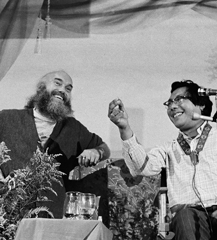KEY INTERVIEWS
Robert Thurman
The New York Times recently said Thurman "is considered the leading American expert on Tibetan Buddhism." Time chose him as one of its 25 most influential Americans in 1997, describing him as a "larger than life scholar-activist destined to convey the dharma, the precious teachings of Siddhartha, from Asia to America." In 1962, Thurman became the first American ordained as a Tibetan Buddhist monk but he gave up his robes when he discovered he could be most effective in the American equivalent of the monastery - the university. He is now a professor at Columbia University & co-founder and current President of Tibet House U.S., a cultural institution dedicated to preserving and promoting the wisdom and the arts of the distinctive and endangered Tibetan civilization.
Pema Chodron
Pema Chodron is an ordained Buddhist nun in the Tibetan Vajrayana tradition, and a teacher in the lineage of Chögyam Trungpa, her ‘root guru.' She's written five best-selling books, and the success of her first two books, The Wisdom of No Escape and Start Where You Are, made her famous as an understandable and undiluted Buddhist teacher. She teaches extensively, and says that the goal of her work is show how to apply Buddhist teachings in everyday life. She says of Trungpa, "It wasn't what he taught but how he taught that made him different."
Diana Mukpo
Diana Pybus married Chogyam Trungpa (Mukpo is the family name) the day she turned sixteen. Her remarkable book, Dragon Thunder, My Life With Chogyam Trungpa, is described by Lawrence Shainberg as, "Dragon Thunder is as wild and unfathomable, as heartbreaking and irresistible as Don Quixote. As a dharma book, it's mix of sadness and wisdom is so complete that reading it becomes a practice in itself."
Sakyong Mipham
The eldest son of the Vidyadhara Chögyam Trungpa, Jamgon Mipham is the head of the Shambhala Buddhist lineage and is spiritual director of Shambhala, a borderless kingdom of meditation practitioners committed to realizing enlightenment and social harmony through daily life. His two books, Turning The Mind Into An Ally, and, Ruling Your World, extend his father's vision of "creating an enlightened society." He has recorded several spoken-word music videos, including What About Me & Come & Dance.
Bhagavan Das
Bhagavan Das is perhaps most widely known for being the individual who guided renowned spiritual teacher Ram Dass, also known as Dr. Richard Alpert, throughout India, eventually introducing him to his guru. As a young man Bhagavan Das shot to fame in the west after being featured in Ram Dass' spiritual classic Be Here Now. BD told us many great stories of Chogyam Trungpa's wisdom, such as the night BD passed out after a night of drinking, and woke up to find that Trungpa had cut off BD's famous coiled hair braids. "I simply remember being so grateful to him for freeing me of my hair. I felt light, you know, and cool and happy. And I just bowed to him and said, "Thank you very much." And he bowed and said, "You're welcome."
James George
The former Canadian High Commissioner, recognized Trungpa's exceptional abilities and helped him get a Spaulding sponsorship to go to England and study at Oxford. George remembers telling Trungpa, "You're going to find England and Scotland too small for you. I think you're going to need the space of North America for your terrain, your teaching ... that's where your destiny lies."
Allen Ginsberg
The renowned poet studied with Trungpa for years and helped create the Jack Keroac School of Disembodied Poetry at Naropa Institute. Ginsberg credited Trungpa with teaching him to trust his own mind. He said that "We had a deal - I was his poetry teacher and he was my meditation teacher. I think I definitely got the better end of the deal."
Jeffery Paine
The author of Re-Enchantment: Tibetan Buddhism Comes to the West, Father India, and other books, Paine never knew or studied with Chogyam Trungpa directly. But he writes in Re-enchantment, "In the story of Tibetan Buddhism in the west, 1970 is an almost prehistoric date...... By the decade's end however, the religion was firmly entrenched. It was a human whirlwind who wrought this change, but at first glance Trungpa looked so unimpressive he was often mistaken for a little Chinese man in a business suit." >.
Ram Dass
Dr. Richard Alpert was a Stanford-educated psychologist and former Harvard professor when he first traveled to India in 1967. It was there that he met his guru, Neem Karoli Baba, who gave him his Hindu name "Ram Dass, meaning "servant of god". In India, Ram Dass studied yoga and ahimsa, and was eventually inspired to write "Be Here Now", the classic work of spirituality celebrating conscious and joyous living. He later established the nonprofit Hanuman Foundation, and the Prison Ashram Project and helped to establish the Living/Dying Project.



